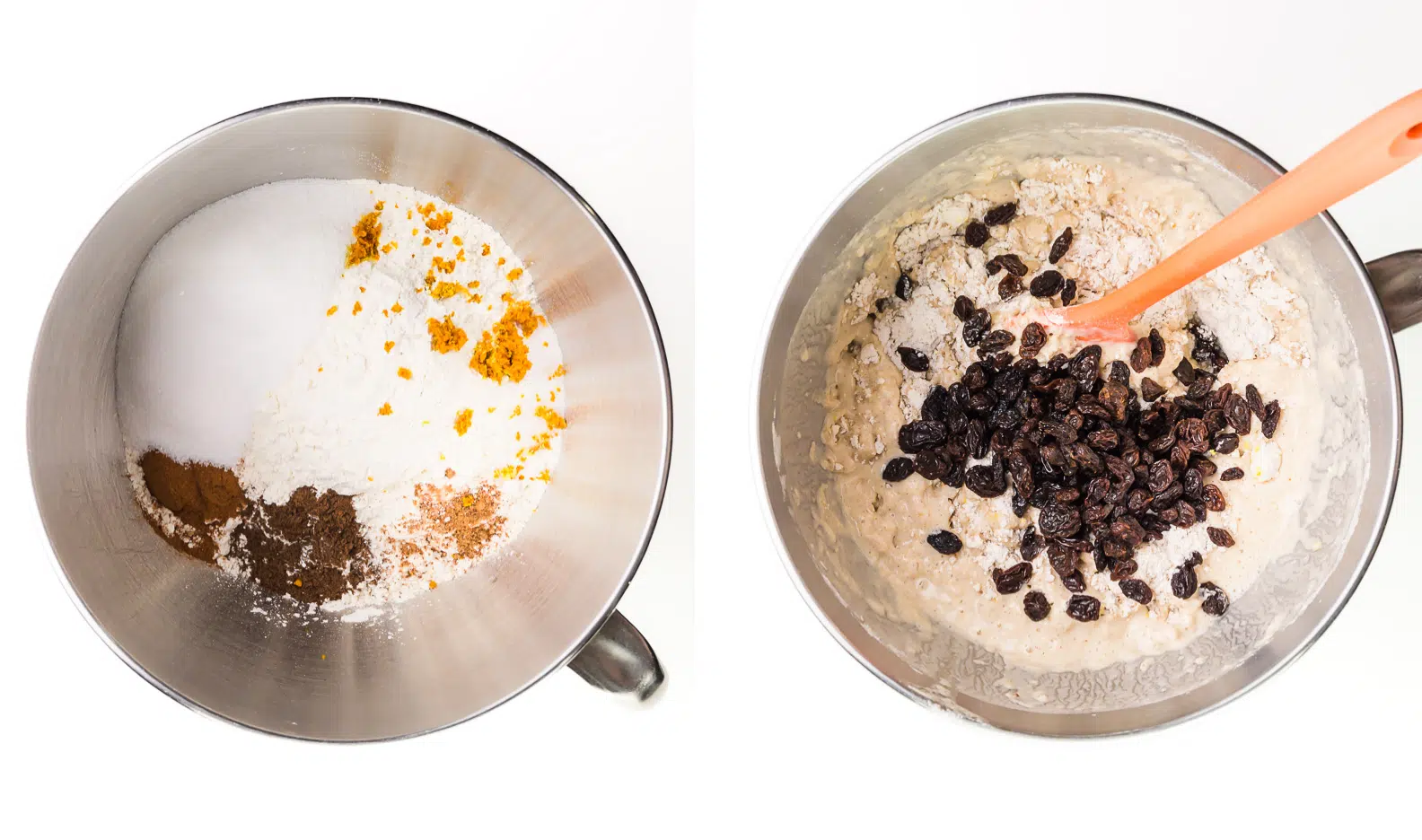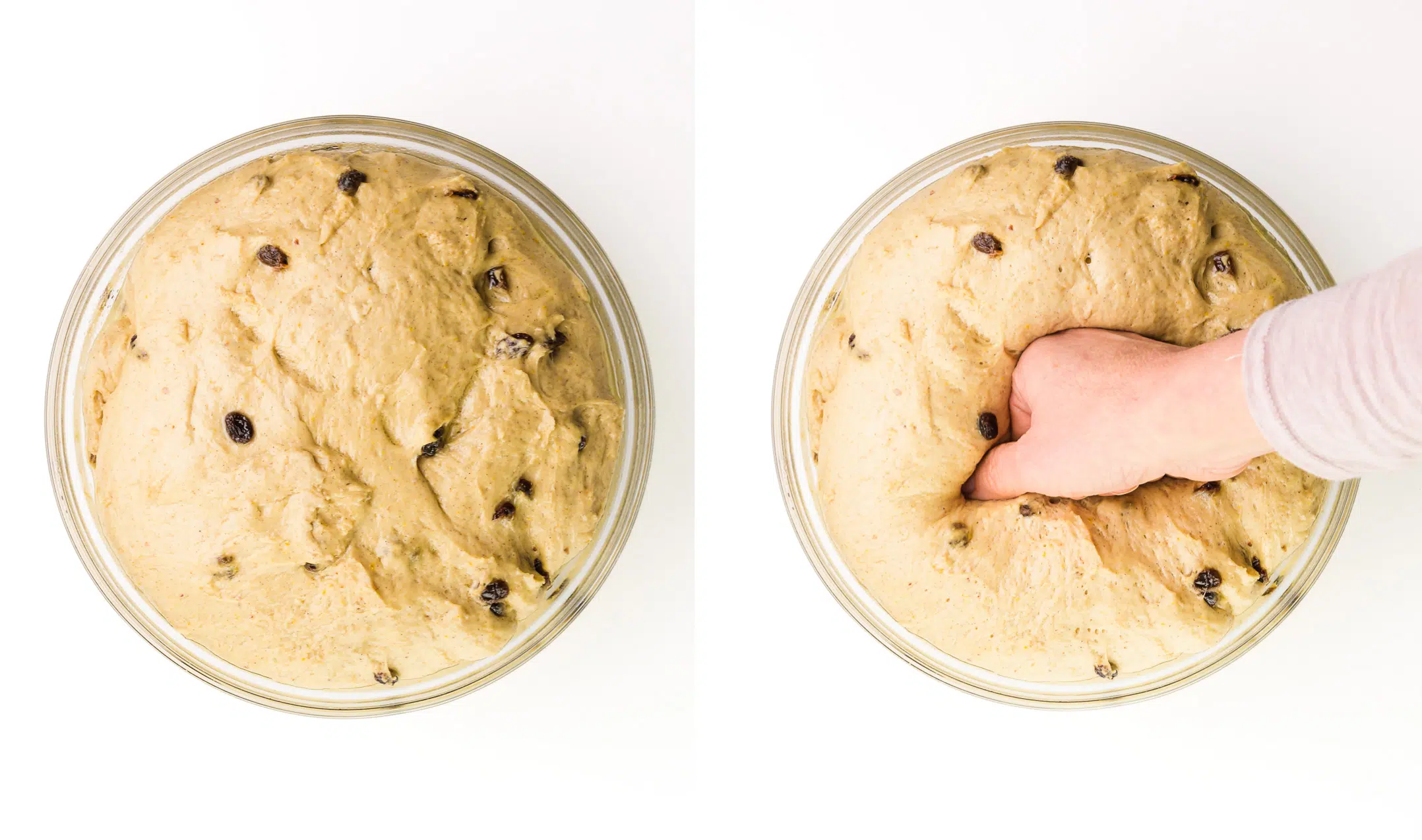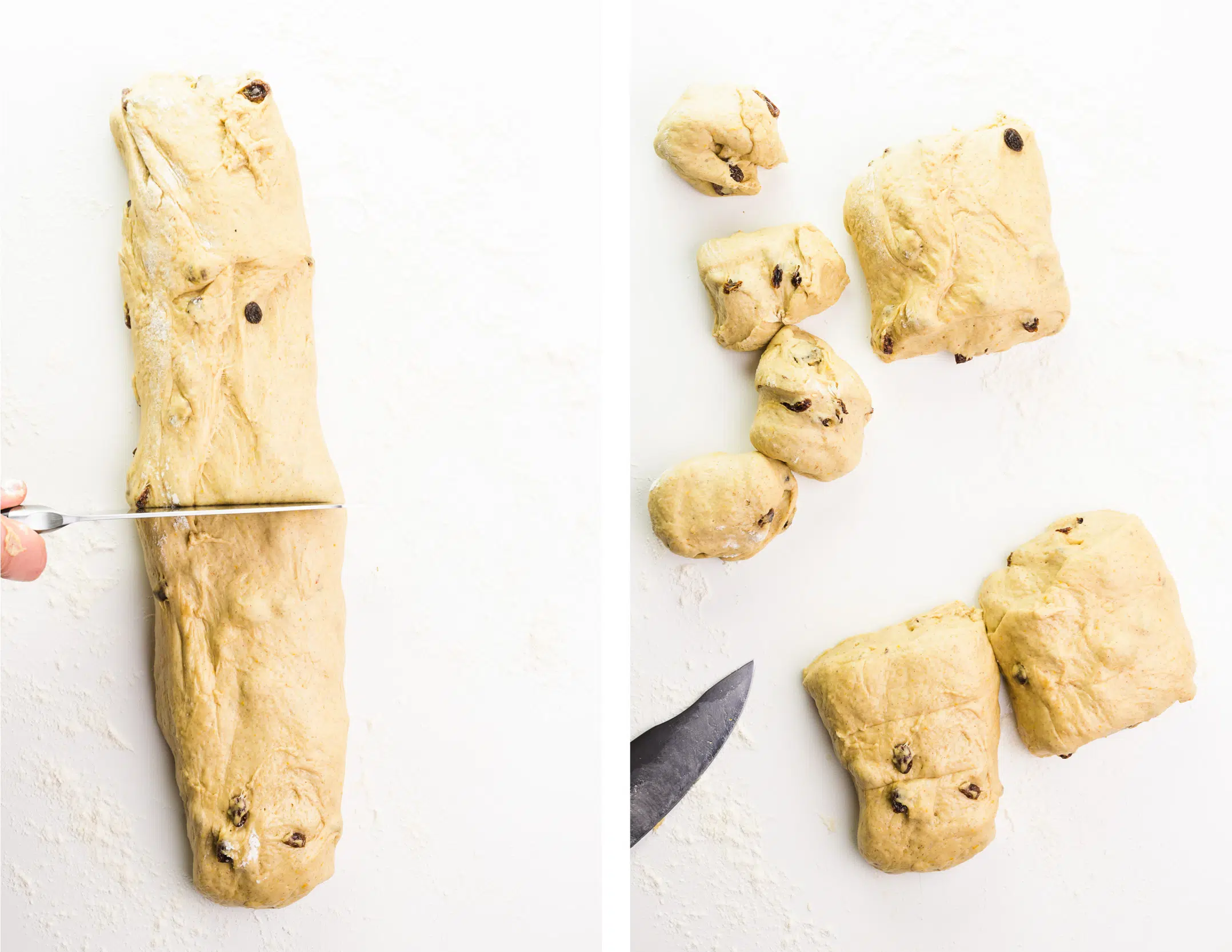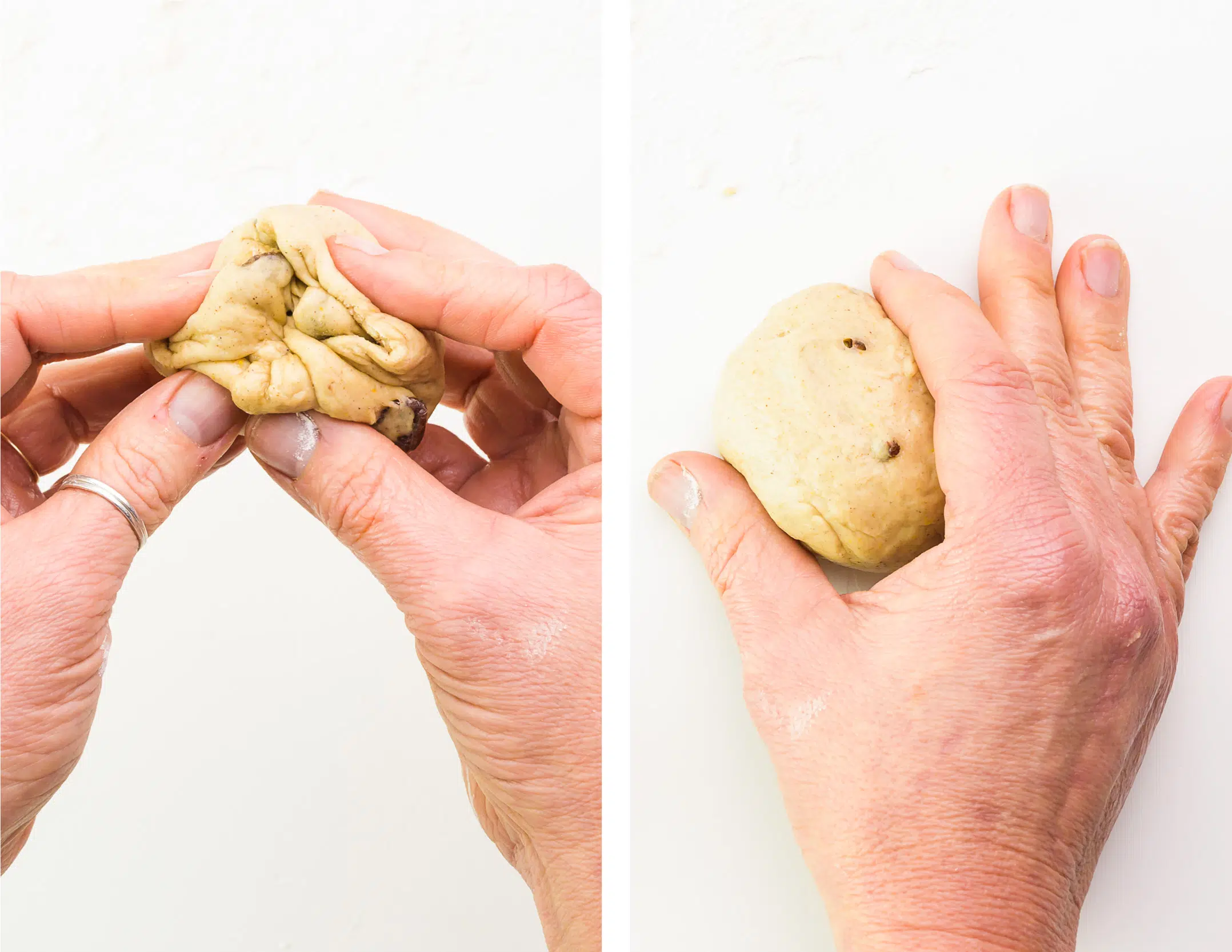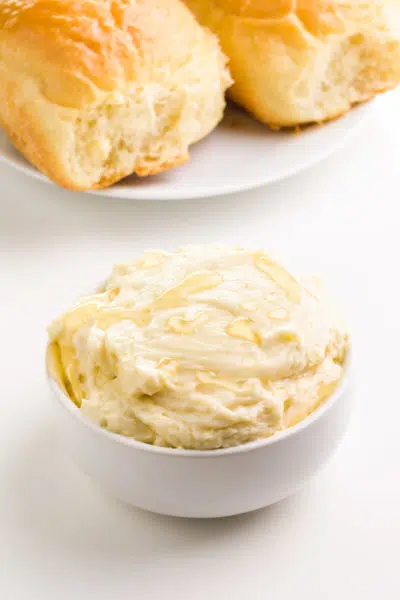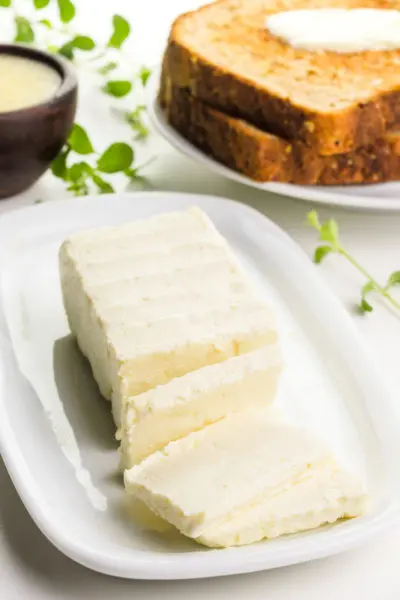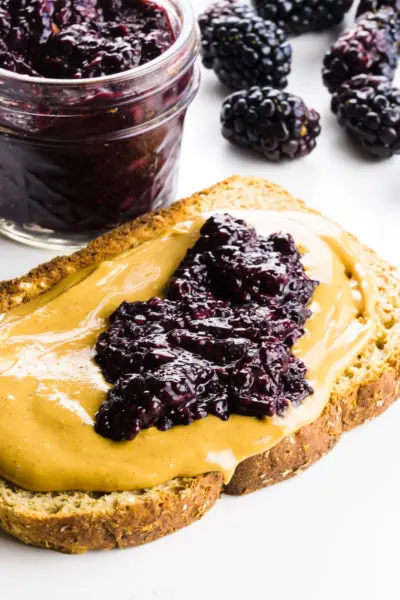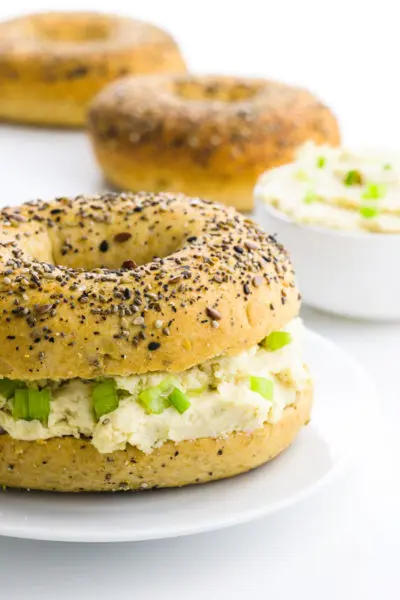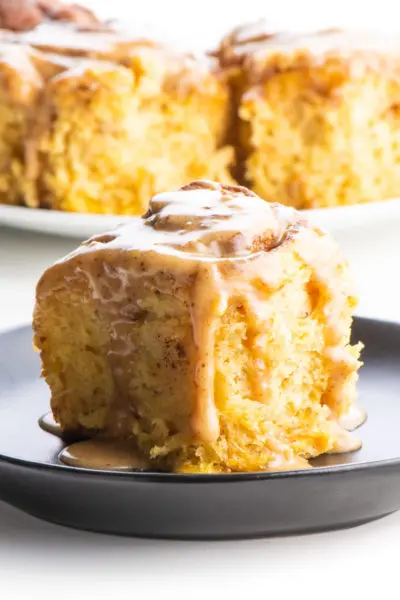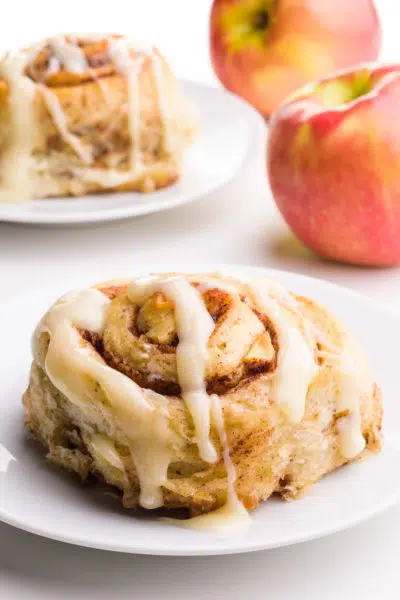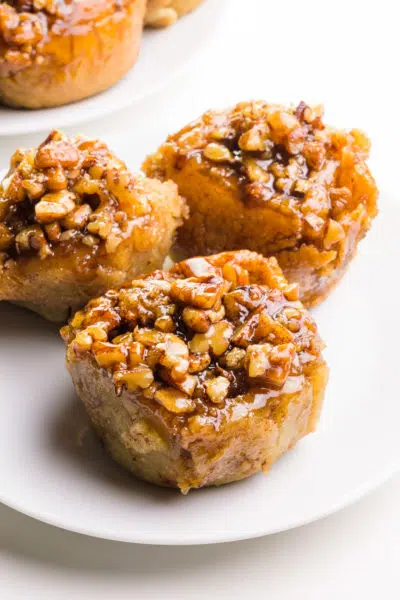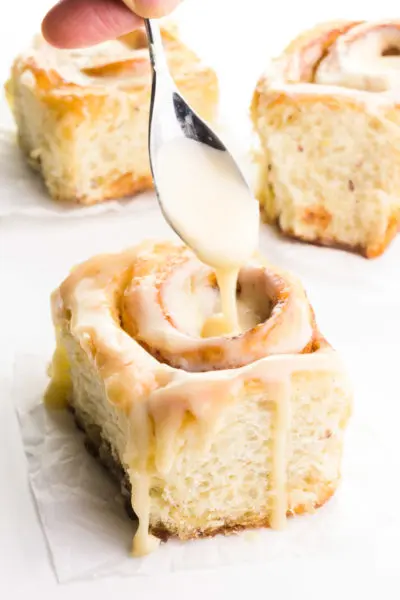Vegan Hot Cross Buns
Make these vegan hot cross buns with traditional crosses baked right into the buns! Enjoy the spice-infused buns made with raisins and orange zest and topped with an orange-infused glaze. This lightly sweetened bun is perfect for breakfast or a treat any time of day!
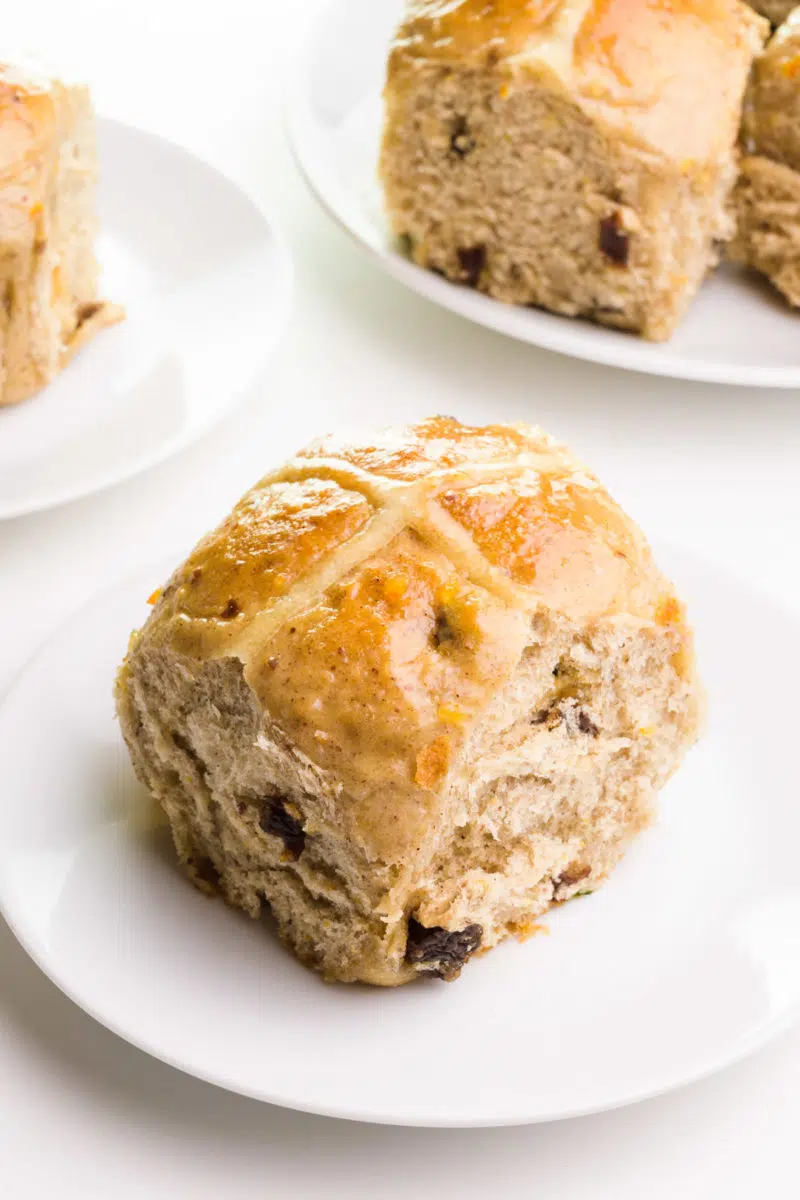
Do you love sweet bread in the morning? Who doesn’t! The smell of bread baking in the oven is intoxicating and tastes pretty amazing, too. For example, my vegan cinnamon bread is a regular favorite!
Hot Cross Buns originated in the pagan religion, where buns with crosses were made and served in honor of the goddess of spring, Eostre. The crosses were said to represent the four phases of the moon, the new moon, the two quarters, and the full moon.
These buns are still served today and at the same time of year, spring. You can enjoy them for breakfast or any time of day. I particularly enjoy serving them with a little bit of vegan honey butter.
Key Ingredients
Here are the ingredients you’ll need for this recipe, including substitution ideas:
- Yeast — We’ll be using 1 packet of i nstant rise yeast. Active dry yeast works, too.
- Sugar — A little bit of granulated sugar is all you need.
- Plant-based milk — I prefer soy milk, but any plant-based milk will work.
- Vegan butter — I recommend using vegan butter that’s made for baking or make your own vegan butter.
- Flour — I recommend using bread flour because it has a higher protein level, resulting in softer buns. However, you can use all-purpose flour.
- Spices — You’ll need ground cinnamon, ground allspice, and ground nutmeg.
- Salt — Plain table salt is fine or you can use sea salt.
- Orange zest — I know you can use storebought orange zest, but fresh orange zest has the most flavor and is therefore the best. You’ll need the zest from one orange.
- Raisins — You can use regular raisins, golden raisins, or even dried cranberries or currants.
- Orange marmalade — We’ll be using orange marmalade to make the glaze.
- Vanilla extract — A bit of vanilla extract is used in both the dough and the glaze.
How to Make Vegan Hot Cross Buns
You can find the full printable recipe, including ingredient quantities, below. But first, here are some explanations of ingredients and steps to help you make this recipe perfect every time.
Step One: Make the Dough
- Heat water in the microwave for 10 to 15 seconds, until warm (around 110°F/43°C).
- Add 2 teaspoons of sugar and yeast to the water and stir gently until combined. Set aside for 5 minutes until it’s frothy on top. If it does not get frosty, do this step over with a fresh packet of yeast.
- Combine milk and butter in a microwave-safe bowl. Microwave for 30 seconds, stir, and repeat. Do the finger test again. It should be warm (around 110°F/43°C), but not hot. Then add this milk mixture to the frothed yeast mixture.
- Whisk together remaining sugar, flour, spices, and salt in a large mixing bowl.
- Pour the yeast mixture along with the orange zest and raisins into the flour. Stir together until combined and no large lumps of flour remain.
- Knead the dough. Do this by hand on a lightly floured surface for up to 10 minutes. Using a stand mixer with the dough hook attachment, knead the dough for 5 minutes. The dough should be smooth and elastic (should spring back when pressed and won’t break when stretched).
Step Two: Rise #1
- Spray a very light coating of vegetable spray on top of the loaf.
- Cover with a wet kitchen towel
- Set aside in a warm, draft-free place to rise (see post notes for ideas) for about an hour.
Step Three: Form Dough Balls
- Once the dough has risen, punch it down to deflate it.
- On a lightly floured working surface, turn the dough out.
- Shape it into a log. Cut the log in half, then cut each half into 6 equally-sized pieces, creating 12 pieces.
- Pull up the sides of one piece of the dough to create a round formation. Then place the dough creases side down. Cup the ball with your hand and gently roll it in a circular motion on a flourless surface. It will begin to form a round roll.
- Place the rolls in the prepared pan and repeat with the remaining pieces, arranging them so there is space between each bun.
Step Two: Rise #2
- Place the rolls in the prepared pan arranging them so there is space between each bun.
- Spray the tops of the buns with a light coating of vegetable cooking spray. Cover the pan with plastic wrap (sprayed with vegetable cooking spray). Set aside in a dark, draft-free location to rise for 30 minutes or so, until almost double in size.
- Stir together the vegan egg wash ingredients. Gently brush the egg wash over the rolls, being careful not to push in (and therefore deflate) the buns.
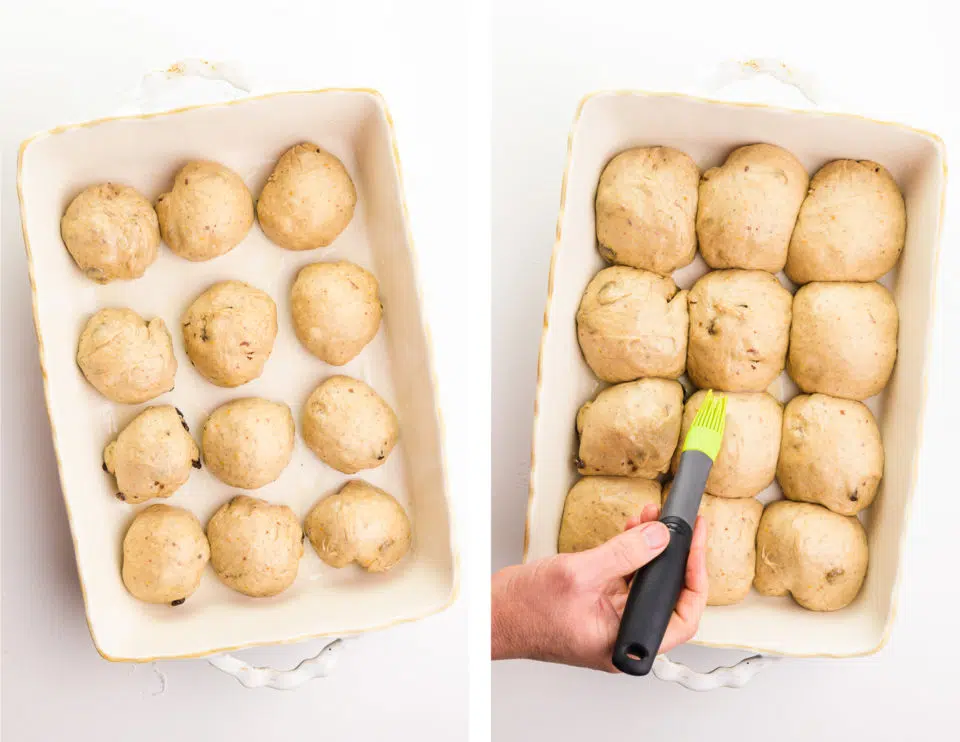
Step Five: Add the Crosses
- Mix the cross ingredients (flour and water), to create a thick paste. It should be thick enough to pour, but not so thin that it runs down the sides of the buns.
- Spoon the flour mixture into a piping bag fitted with a small round tip (3mm tip).
- Slowly pipe horizontal lines across all the buns. Then turn the pan and pipe lines to create crosses.
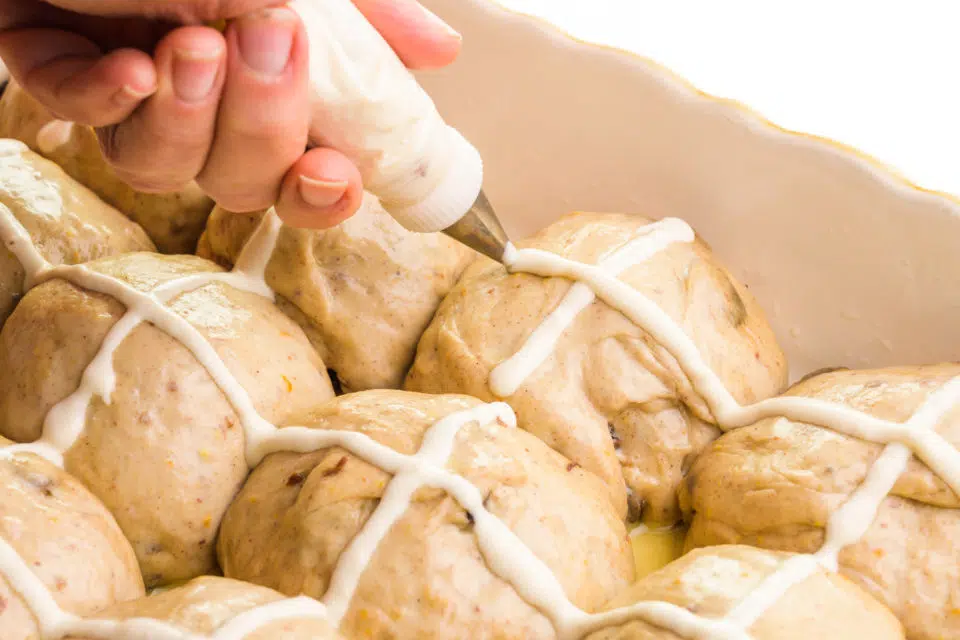
Step 6: Bake the Buns & Glaze
- Bake buns for 20 to 22 minutes, until the tops are golden brown.
- When they’re done, remove the buns from the oven. Allow them to cool slightly, then remove them from the pan.
- Combine glaze ingredients in a bowl. Microwave for 10 to 20 seconds then stir to combine.
- Brush the glaze over the buns while they’re still warm.
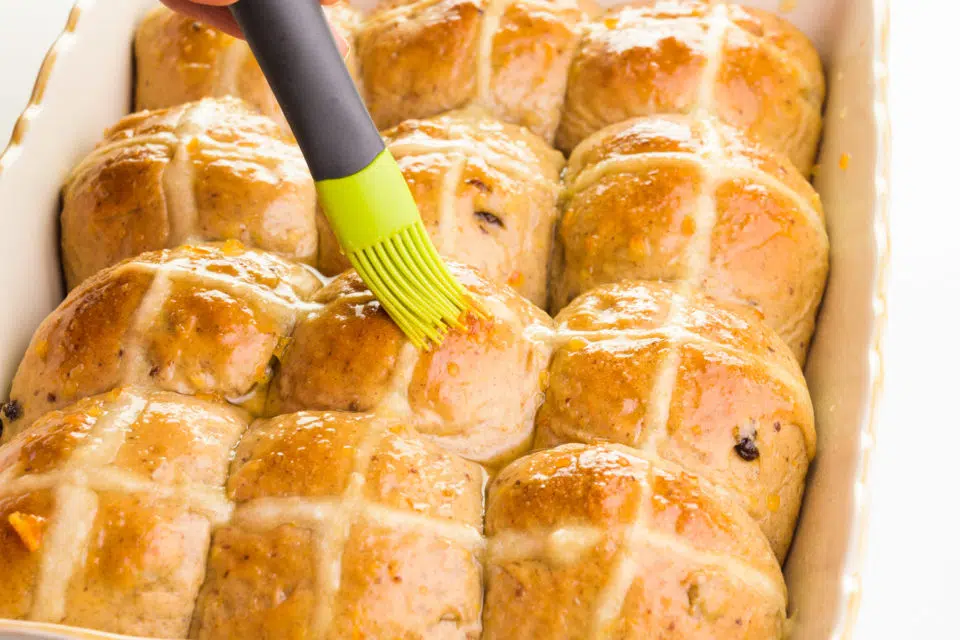
Places to Let Dough Rise
Let dough rise in a warm, draft-free place. That sounds pretty simple, right? The challenge can be finding a place like that in your kitchen. Here are some of my favorite ways to encourage the dough to rise:
- The Microwave — This is my favorite! I add a coffee mug full of water. I heat it for 1 to 2 minutes until it’s really hot. Then I scoot it to the side and add the covered dough. The steam from the water heats up the microwave, a perfect place to let the dough rise.
- The Oven — To let the dough rise in the oven, turn it on to a low-temperature setting, like 200°F. Then turn it off after 2 minutes. Add the covered dough and let it rise. Another idea is to add a pot with boiling water to create a warm, moist environment for your dough.
- Stovetop — If your oven is like mine, it has a warming plate for the stovetop. I turn this on for a few minutes, then turn it off (this part is important), place a folded kitchen towel over it (so as not to bake the bottom of the dough), and place the covered bowl on top of the warm towel. Make sure it’s warm and not hot.
- Other mysterious locations — I’ve read where people use the dryer, but I’ve not tried this myself! It sounds like potential for disaster, but it just shows how creative people can be!
Icing Crosses
If you prefer to use icing instead of this traditional cross, skip this step and combine powdered sugar with a tablespoon (or two) of plant-based milk or orange juice. Stir and then pipe crosses on baked, cooled buns.
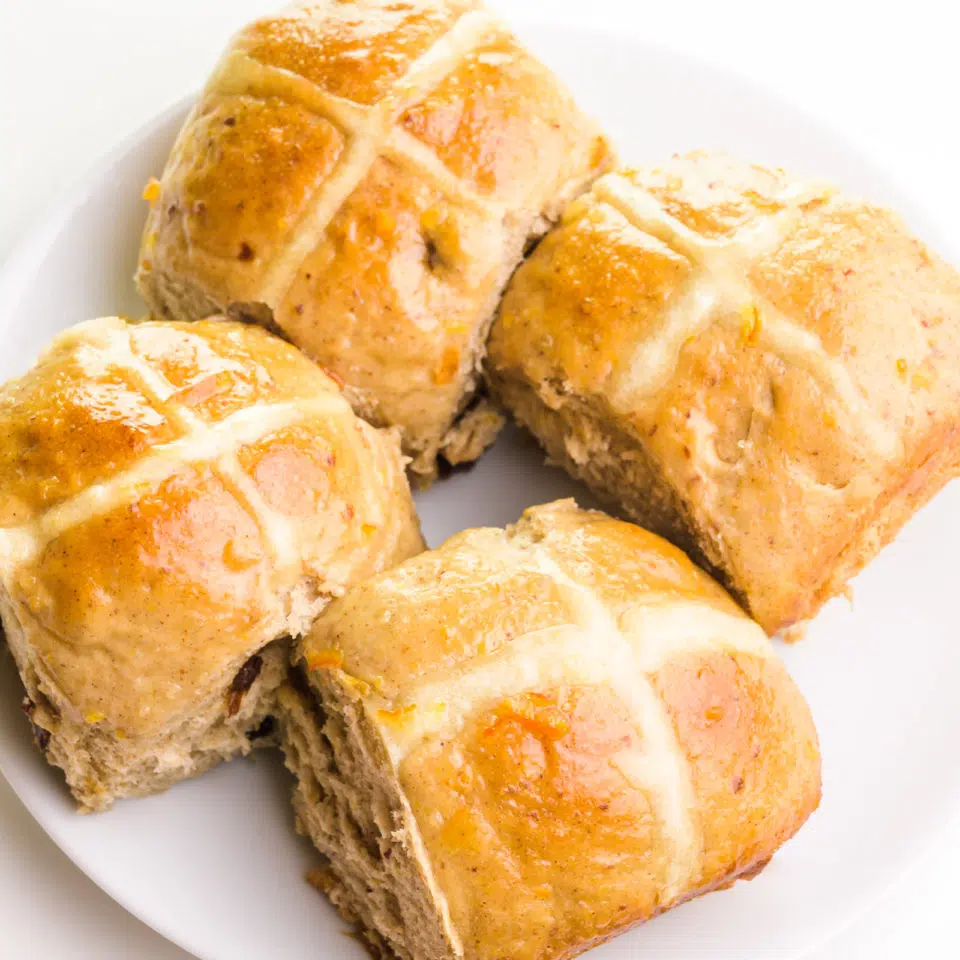
What Makes This Recipe Shine?
- YUMMY — Adding raisins to the dough helps distribute them throughout the buns.
- TRADITIONAL — Piping crosses onto the bun before they bake creates a traditional hot cross bun, with the crosses baked into the top.
- FLAVOR — Adding fresh orange zest to the dough adds delicious flavor throughout each bun.
Frequently-Asked Questions
Are hot cross buns vegan?
A typical hot cross bun is not vegan because the dough is made with eggs and dairy. However, it’s quite easy to make them vegan at home. In addition, some storebought versions may be vegan as well.
When do you eat hot cross buns?
Hot cross buns are typically served and eaten in the spring. It’s also regularly served as a breakfast bun, but you can eat them any time of day.
Serving Suggestions
Serve this vegan hot cross buns with these tasty toppings:
Storage Tips
Store buns in an airtight container at room temperature for up to 3 or 4 days, in the fridge for up to 7 days or in the freezer for up to 2 months.
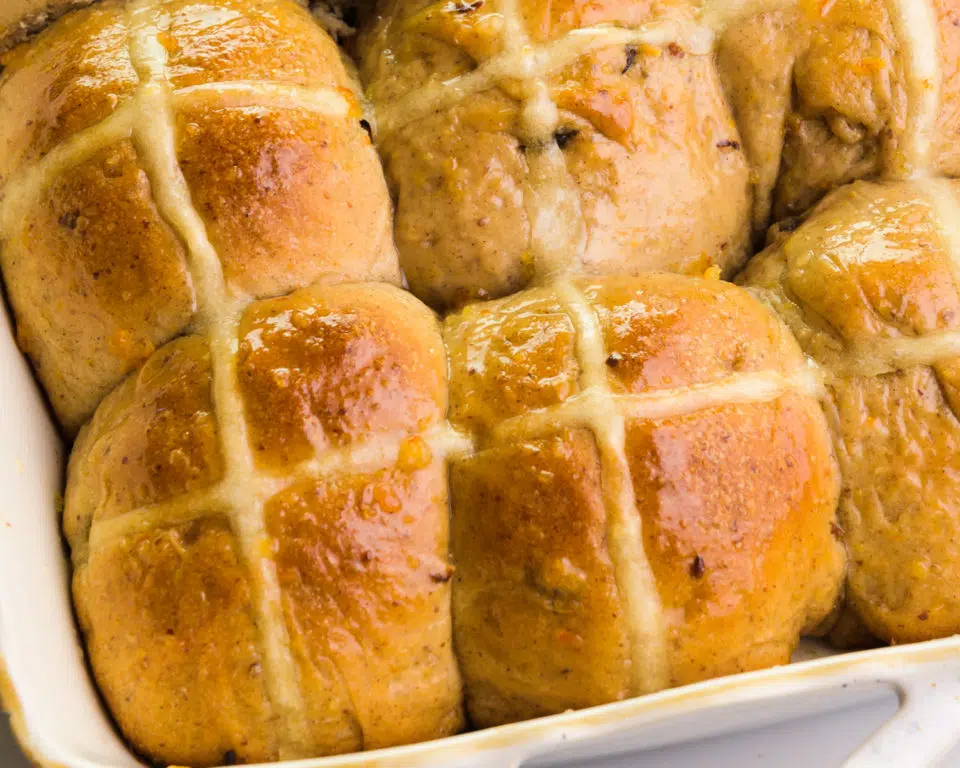
Vegan Bun Recipes
If you love vegan hot cross buns, here are even more tasty vegan bun recipes you can try!

Vegan Hot Cross Buns
Ingredients
Buns
- 2 ¼ teaspoons instant rise yeast (1 packet)
- ½ cup granulated sugar, divided
- ½ cup water
- ¾ cup plant-based milk (prefer soy milk)
- 4 tablespoons vegan butter
- 4 cups bread flour plus 2 to 3 tablespoons
- 1 ½ teaspoons ground cinnamon
- ½ teaspoon ground allspice
- ¼ teaspoon ground nutmeg
- 1 teaspoon salt
- 1 tablespoon freshly grated orange zest
- ¾ cup raisins
Vegan Egg Wash
- 1 tablespoon vegan butter, melted
- 1 teaspoon plant-based milk
Crosses
- ¼ cup all-purpose flour
- 2 tablespoons water
Glaze
- 1 tablespoon orange marmalade
- ½ teaspoon vanilla extract
- 1 – 2 teaspoons water
Instructions
For the Buns:
- Heat water in the microwave for 10 to 15 seconds, until warm (around 110°F/43°C). You should be able to stick your finger in it and not feel too much of a difference.
- Add 2 teaspoons of sugar and yeast to the water and stir gently until combined. Set aside for 5 minutes until it's frothy on top. If it does not get frosty, do this step over with a fresh packet of yeast.
- Combine milk and butter in a microwave-safe bowl. Microwave for 30 seconds, stir, and repeat. Do the finger test again. It should be warm (around 110°F/43°C), but not hot. Then add this milk mixture to the frothed yeast mixture.
- Whisk together remaining sugar, flour, spices, and salt in a large mixing bowl.
- Pour the yeast mixture along with the orange zest and raisins into the flour. Stir together until combined and no large lumps of flour remain.
- Knead the dough. Do this by hand on a lightly floured surface for up to 10 minutes. Using a stand mixer with the dough hook attachment, knead the dough for 5 minutes. The dough should be smooth and elastic (should spring back when pressed and won't break when stretched).
Rise #1:
- Spray a very light coating of vegetable spray on top of the loaf. Cover with a wet kitchen towel, and set aside in a warm, draft-free place to rise (see post notes for ideas) for about an hour.
Form Dough Balls:
- Line a 9×13-inch baking pan with parchment paper. Give it a light coating of vegetable spray.
- Once the dough has risen, punch it down with your fist.
- On a lightly floured working surface, turn the dough out. Then use your hands to shape it into a log. Cut the log in half, then cut each half into 6 equally-sized pieces, creating 12 individual pieces.
- Roll into Balls. Pull up the sides of one piece of the dough to create a round formation. Then place the dough creases side down. Cup the ball with your hand and gently roll it in a circular motion on a flourless surface. It will begin to form a round roll.
- Place the rolls in the prepared pan and repeat with the remaining pieces, arranging them so there is space between each bun.
Rise #2:
- Spray the tops of the buns with a light coating of vegetable cooking spray. Cover the pan with a dampened kitchen towel or plastic wrap (sprayed with vegetable cooking spray). Set aside in a dark, draft-free location to rise for 30 minutes or so, until almost double in size.
For the Vegan Egg Wash:
- Stir together the vegan egg wash ingredients. Gently brush the egg wash over the rolls, being careful not to push in (and therefore deflate) the buns.
Adding Crosses:
- When the buns are almost done rising, preheat your oven to 375°F/191°C.
- Mix the cross ingredients (flour and water), to create a thick paste. It should be thick enough to pour, but not so thin that it runs down the sides of the buns. If you prefer to use icing instead of this traditional cross, skip this step and combine powdered sugar with a tablespoon (or two) of plant-based milk or orange juice. Stir and then pipe crosses on baked, cooled buns.
- Spoon the flour mixture into a piping bag fitted with a small round tip (3mm tip).
- Slowly pipe horizontal lines across all the buns. Then turn the pan and pipe lines to create crosses.
Baking Buns:
- Bake buns for 20 to 22 minutes, until the tops are golden brown.
- When they're done, remove the buns from the oven. Allow them to cool slightly, then remove them from the pan.
Glazing Buns:
- Combine glaze ingredients in a bowl. Microwave for 10 to 20 seconds then stir to combine.
- Brush the glaze over the buns while they're still warm.
(The products above contain sponsored links to products we use and recommend)
The nutrition information shown is an estimate provided by an online nutrition calculator and should not be considered a substitute for a professional nutritionist’s advice.

